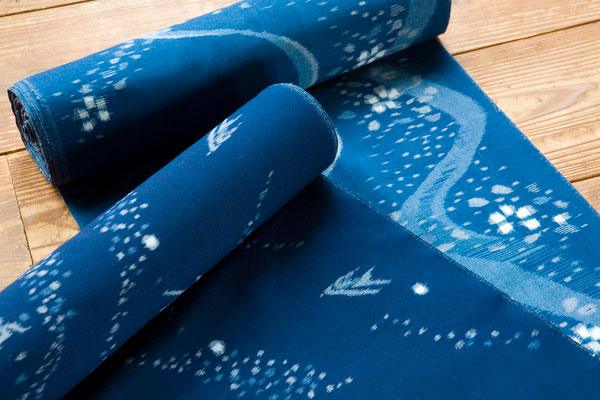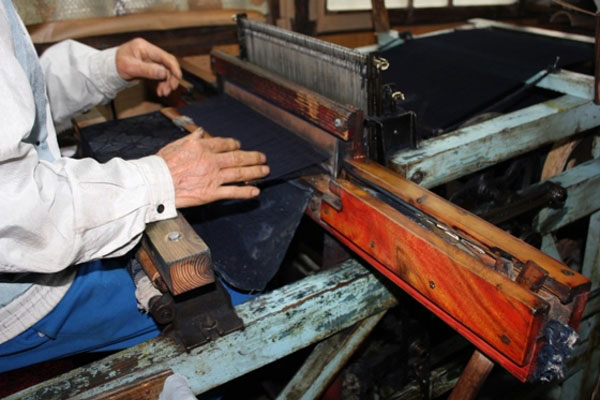
- Woven textiles
- Fukuoka
Kurume traditional resist-dyed textiles Kurume gasuri
An indigo textile invented by a little girl from Kurume
that gets finer with every wash
Description
What is Kurume traditional resist-dyed textiles ?
Kurume traditional resist-dyed textiles (Kurume gasuri in Japanese) is a woven cloth produced in and around the city of Kurume, Fukuoka prefecture. The breathability assures coolness in the summer and excellent heat-retaining properties provide warmth in the winter. By wearing it repeatedly, the cotton cloth becomes more fit and the texture gets better. These textiles also have an excellent durability which makes them perfect for daily wear. Advance in techniques contributed to development in the design patterns, like large or small patterns and patterns of small pictures. With its indigo-blue color and delicate patterns, Kurume gasuri has a pleasant appearance. It is renowned as one of the three most famous traditional resist-dyed textiles along with Bingo gasuri and Iyo gasuri. Because the cotton resist-dyed kasuri fabric improves over time, it is a textile that can be enjoyed for a long time.
History
One day a twelve year old girl named Den INOUE from Kurume noticed that washing an indigo-dyed kimono repeatedly decolorizes the kimono, and makes white faded dots in the fabric. Her curiosity led to detangling the threads to examine the faded dots and she was inspired to dye new threads in the same way as the detangled threads. Her fabric was called kasuri and was welcomed to the market. She developed techniques to add pictorial patterns in the kasuri, which led to gradual increase in production and number of disciples. By the time she was thirty eight years old in 1827, she had over 1000 disciples, among which 400 spread all over the country, promulgating Kurume traditional resist-dyed textiles nationwide and establishing this textile's position in the industry. Kimono fabrics were worn among the common people, but the production started taking a downturn with the switch to Western clothes. Some say the time of Kasuri fabrics has passed, but there is an effort to reinvigorate the industry by making modern items for daily use, and some artisans are making Western clothes out of kasuri kimonos.
General Production Process

- 1. Designing the pattern The first step is visualizing and designing the complete pattern.
- 2. Drawing the design The design, including the size, number of reed dents, and the amount of warps and wefts (the two basic components of thread) are drawn on a special paper.
- 3. Preparing the measuring stick The places to bind the threads are marked on a 5- or 6-mm bamboo stick.
- 4. Draft drawing A design that allows for the shrinkage of weft threads is redrawn based on the first draft.
- 5. Marking with thread Patterned threads are used as a mark for binding weft threads.
- 6. Warping Based on the design, the necessary number of warp threads are prepared.
- 7. Arranging weft sets The artisan prepares the necessary number of wefts. The wefts are arranged into sets which consist of 20 threads each.
- 8. Refinement By boiling the threads, the threads are strengthened and impurities are removed.
- 9. Bleaching The threads are bleached with a solution made from a mixture of supernatant liquid of water solution of bleaching powder and sodium bicarbonate.
- 10. Sizing Sizing is applying diluted starch paste to the threads to keep them together.
- 11. Binding the warps The warps are bound around the bamboo measuring stick while stretching evenly. The wefts or perpendicular threads are tied where they are marked to create the patterns.
- 12. Fermenting A high quality indigo dye is prepared by fermenting for seven to ten days.
- 13. Indigo dyeing An indigo dye vat is used for the indigo dyeing process. Dyes are prepared by their concentration and the dyeing begins from low concentrated dye and then moves to higher concentrations. The dyed threads are struck well.
- 14. Washing Any stains and lye from the dyeing are washed off.
- 15. Detangling
The washed threads are quickly detangled before they are dry.
- 16. Washing and bleaching The detangled threads are placed in water.
- 17. Sizing and drying A diluted starch paste is applied to the threads to keep them together and the threads are then dried.
- 18. Pattern alignment This process involves tying the dyed threads into a bundle that is based on the patterns.
- 19. Sizing and drying The threads are starched and dried again. Proper sizing and drying can make the weaving easier.
- 20. Setting the threads
Two of each warp and ground threads are drawn through a reed dent.
- 21. Warps reeling The warps are reeled into a winding box.
- 22. Heddling A pair of threads is taken off from the reed dent. The threads are separated into a single thread and put through a heddle.
- 23. Setting on the weaving machine The threads are set on a hand weaving machine.
- 24. Mark removal The thread markings are removed and the dyed threads are separated.
- 25. Winding
The dyed thread bundle is reeled onto a weft cassette.
- 26. Reeling on a bamboo tube The dyed thread bundle is reeled onto a bamboo tube.
- 27. Hand weaving Hand weaving requires high level skills. A shuttle weaving machine is used.
- 28. Drying After completing the hand weaving, the cloth is desized and dried in the shade.
- 29. Adjusting the size The width of the cloth is checked and the cloth is cut to the predetermined size.
- 30. Inspection Finally, an inspection is done by the Kurume Kasuri Cooperative Association.
Where to Buy & More Information
Takumi Art & Craft Gallery

-
Address
-
Tel.+81-92-725-9100
-
Closed2nd and 4th Monday of the month
-
Business Hours10am to 7pm
-
Website
See more Woven textiles
- Nishijin brocade
- Yuki tsumugi silk
- Kurume traditional resist-dyed textiles
- Ojiya chijimi textiles
- Hakata brocade
- Ushikubi tsumugi silk
- Chichibu-meisen silk
- Miyako ramie textile
- Shiozawa tsumugi silk
- Kumejima tsumugi silk
- Omi ramie cloth
- Ryukyu traditional resist-dyed textiles
- Kiryu brocade
- Murayama-oshima tsumugi silk
- Yumihama traditional resist-dyed textiles
- Chibana-hanaori textiles
- Hon-shiozawa silk
- Oitama tsumugi silk
- Ojiya tsumugi silk
- Yaeyama cotton cloth
- Yaeyama ramie cloth
- Honba oshima tsumugi silk
- Shinshu tsumugi silk
- Shuri brocade
- Tama brocade
- Yomitanzan-hanaori textiles
- Isesaki traditional resist-dyed textiles
- Hachio island silk
- Nibutani bark cloth
- Uetsu tilia bark cloth
- Awa-shijira cotton cloth
- Kijoka banana fiber cloth
- Tokamachi traditional resist-dyed textiles
- Tokamachi akashi chijimi textiles
- Yonaguni brocade
- Yuntanza minsa
- Flower pattern textiles
- Oku-Aizu Showa Karamushi Textiles































































































































































































































































































